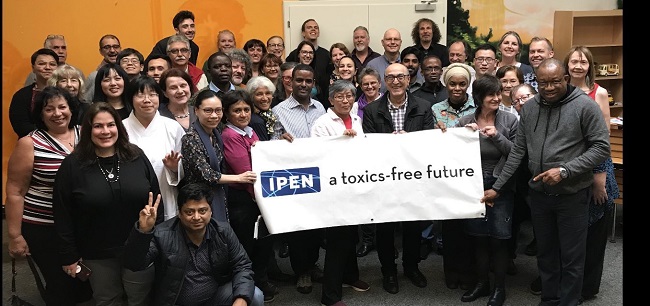Governments at the 9th Conference of the Parties (SC COP9) of the Stockholm Convention on Friday, May 3, 2019 in Geneva, Switzerland agreed to a global ban on PFOA – a chemical that does not break down and causes adverse health effects at background levels.

The uses of PFOA and other fluorinated organic compounds (PFAS) are widespread across many industrial and domestic applications. Fluorinated firefighting foams are said to be a leading cause of water contamination with toxic chemicals that pollute breast milk and are associated with cancer, endocrine disruption, and harm to fetal development.
SC COP9 is one of the Meetings of the conferences of the Parties to the Basel, Rotterdam and Stockholm (BRS) conventions holding back to back in Geneva. They started on Monday, April 29 and will end on Friday, May 10.
Others are the fourteenth meeting of the Conference of the Parties to the Basel Convention (BC COP14), and the ninth meeting of the Conference of the Parties to the Rotterdam Convention (RC COP9). The theme of the meetings is: “Clean Planet, Healthy People: Sound Management of Chemicals and Waste”.
Governments at the SC COP9 also included several five-year exemptions for PFOA use in semiconductor manufacturing, firefighting foams, textiles claimed to protect workers, photographic coatings for films, and medical devices.
China, European Union and Iran obtained additional wide-ranging exemptions for fluorinated polymers, medical textiles, electrical wires, and plastic accessories for car interior parts. All three countries participated in the evaluation process, but suddenly asked for the additional exemptions at the meeting. Even the fluorochemicals industry repeatedly opposed these additional exemption requests due to the wide availability of alternatives.
“This global ban on PFOA and the warning about not using PFAS alternatives starts a new era in addressing this entire class of persistent, toxic chemicals,” said Dr. Mariann Lloyd-Smith, National Toxics Network and IPEN Advisor. “However, some governments betrayed the treaty’s scientific review process by suddenly adding vast, wide-ranging loopholes that continue PFOA’s cycle of harm.”
Governments placed special controls on PFOA-containing firefighting foams, prohibiting production, export or import and not permitting their use in training – a large source of water pollution. In addition, they warned against using the entire class of PFAS substances because they, “could have negative environmental, human health and socioeconomic impacts due to their persistency and mobility.”
Before the meeting, industry fire experts and firefighters released a new report demonstrating that cost effective fluorine-free firefighting foams meeting regulatory standards and have been widely adopted by world-class airports and major companies.
“From a firefighter’s perspective, we know we have significantly raised PFAS levels in our blood,” said Commander Mick Tisbury, Melbourne Metropolitan Fire Brigade, and United Firefighters Union (UFU), Australia. “We feel we have a ticking time-bomb in our bodies; we do not know when it will explode or even if it will explode – we just want the bomb removed!”
“Governments should listen carefully to industry fire safety professionals and firefighters who actually put out fires and rapidly move to phase out fluorinated firefighting foams,” said Pamela Miller, IPEN Co-Chair. “Water is a precious resource and clean water a fundamental human right. Now is the time to fulfill the Stockholm Convention’s protective objective and stop polluting it.”
In 2009, governments restricted PFOS, but also included numerous exemptions. COP9 moved to substantially tighten PFOS prohibitions ending use in photo-imaging, photo-resist and anti-reflective coatings for semiconductors; etching agent for compound semiconductors and ceramic filters; aviation hydraulic fluid; certain medical devices; photo masks in semiconductor and LCD industries; decorative metal plating; electric and electronic parts for some color printers and color copy machines; insecticides for control of red imported fire ants and termites; and chemically-driven oil production.
Governments placed a new five-year deadline to end PFOS use in firefighting foams and prohibited its production, export or import and use for training.
“These loopholes should have never been approved in the first place,” said Joe DiGangi, IPEN Senior Science and Technical Advisor. “But sharply prohibiting PFOS puts another nail in the coffin of PFAS use and pollution.”
However, use of a toxic pesticide, sulfluramid, which degrades to PFOS, continues with no time limit. Sulfluramid use has proliferated widely in Latin America, causing widespread PFOS pollution.
“The continued use of sulfluramid in agriculture with no time limit protects Brazilian chemical companies, not human health and the environment,” said Fernando Bejarano, IPEN Hub for Latin America. “Governments should transition to agroecological techniques and ban this pollution source as soon as possible.”
